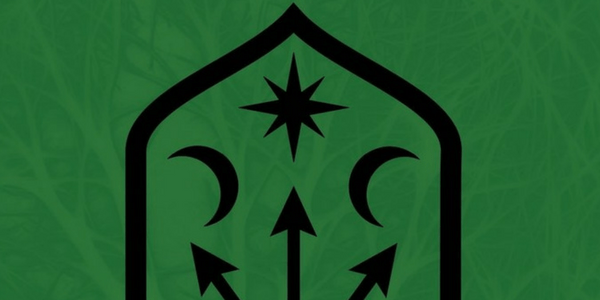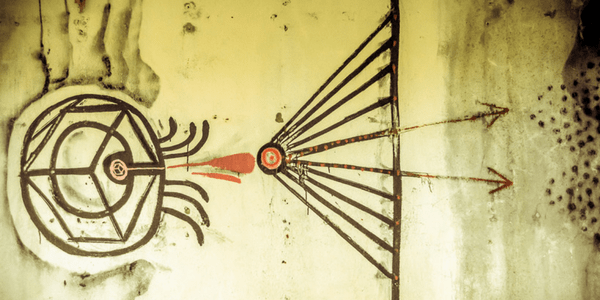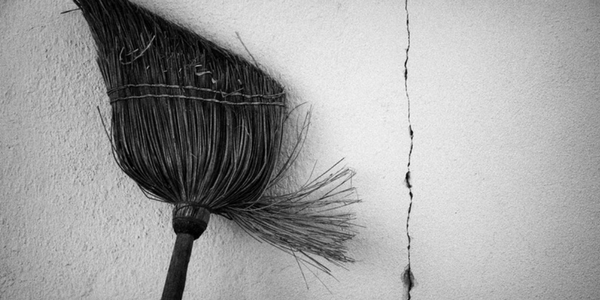 CHAOS KAOS KAYOS CHAYOS KAIOS QUAIOS QUAYOS KAIYOS
CHAOS KAOS KAYOS CHAYOS KAIOS QUAIOS QUAYOS KAIYOS
…to name but a few. Eight is the number of my true love’s name in the morning (7), when I rise (4). This is naturally a sexist riddle, the answer being ERECTION (8), and may or may not be perceived to have much to do with the matter that follows! Yet hard facts persist, even through anarchy, and some of them are pertinent to the discussion which follows.
That the number EIGHT and chaos are inextricably entwined is, by any standards, irrefutable. Yet eight goes back so much further, into the very roots of occultism, and is a number worthy of at least a passing glance.
Eight. The Ogdoad. Westcott has this as the first cube of energy (2*2*2) and adds that it is “the only evenly even number within the decad.” In Greek times it was an omnipotent number, referred to the proverb: “All things are eight.” The Greek connection is at least valid in a passing context, with Hesiod being the first known writer to name chaos and the Mass of Eris in CI 8 (KALLISTI!) could hardly have existed without his significant (if minimal) input.
It was also called the Universal Harmony because of its relationship to the musical scale (DOH, a deer, a female…), which both Mozart and Sol Invictus in their separate ways relied upon. There were eight Cabiri. St Matthew (cap. V) has eight Christian beatitudes, for those who don’t object to a B-attitude. One of the oldest companies of Egyptian Gods, that of Thoth of Hermopolis, consisted of four gods and four goddesses, with the gods being batrachiocephalic and the goddesses being serpent-headed.
The Pentateuch laid down that a male child should be circumcised (i.e. circumscribed for life) when it was eight days old. Stones of eight cubits were to be used for the foundations of Solomon’s temple. Eight tables were provided for the Hebrew slaughter of sacrificial animals. Eight was sacred to Dionysus, who was born in the eighth month. Eight prophet-persons were descended from Rahab the harlot: Seraiah, Jeremiah, Hannemeel, Shallum, Neraiah, Massaiah, Hilkaiah and the prophetess Huldah. The irreverent might be tempted to remark that all these end in a very satisfying AH! Eight souls were saved in Noah’s Ark, and Noah was the eighth in descent. Kabbalistically his name adds to eight times eight.
Theories about numbers can be taken to any lengths, depending upon who’s doing the taking and the bluntness of the axe they intend to grind. The eightfold path of Buddhism is ennobling and uplifting, and it’s only another of the many sets of eight the dedicated occultist will have already discovered.
In the Northern Tradition (my own particular and under-ground axe) Thor’s hall, Bilskirnir, is a prototype skyscraper with 640 (80*8) floors. Valhalla has 640 doors and 960 (8*12) warriors can emerge from each door at once. In the poem Grimnismal Odin doesn’t move for eight nights. When Thor’s hammer is stolen it is hidden eight miles down. To get it back Thor disguises himself as Freya. At the ‘wedding-feast’ which follows, Loki claims Thor hasn’t eaten for eight nights, as Odin’s largest son polishes off eight salmon at a sitting. Eight furnishings and servants are noted in Hel’s palace in the underworld. Odin’s grey mount, Sleipnir, has eight legs. In Lokasenna it is claimed that Loki lived under the earth for eight winters. The three gods which made the first men and woman bestowed eight abilities and faculties upon them.
There are eight runes to an aett in the Common Germanic Futhard, giving eight the strength implied by a full set of anything. In Norse tradition eight is a potent invocatory number, especially for Odin, representing a massive increase of potency over the lesser invocatory number of three.
Another correspondence which must be examined, if we are to do justice to the eight points of the chaosphere, is the eightfold wheel of Wicca. Now, Wicca is a one of those subjects which immediately raises hands, eyebrows and other parts’ of the anatomy whenever it is mentioned, and a brief examination won’t go entirely amiss.
Witchcraft, unlike chaos but very like Norse paganism, is a religion which has been principally recorded by christian commentators with their own bias and ideology to impose. Because off this a great deal of the historical material must be regarded as iffy by anyone seeking to establish the actual truth behind it. One factor which immediately links the topics is the respect offered woman. Woman in the north, as far back as Tacitus writing in the first century AD, was venerated and regarded as having a special gift of wisdom and prophecy. The same is true of the witch cult if we read between the lines. But Christianity, with its attitude that man comes into the world between urine and faeces, took every opportunity to deny and denigrate the role of woman, even within its own ranks. This practice continues today, with the nonconformist sects showing a much greater readiness to contemplate woman’s ordination than the established CofE and RC diehards. Thus any cult which acknowledged woman as an equal and legitimate creature was automatically doomed to censure, if not to rabid shrieks of ‘Heresy!’.
The most telling evidence for associating witchcraft with the Northern Tradition comes from the trials and legislation which led to the persecution. Transvection (flying through the air) for witches goes at least as far back as the Norse poem Havamal in around 950. Use of herbs and salves, not to mention inscribed charms, takes us back into runic times. The archetypal familiar, the cat, is sacred to Freya. A dozen or more similarities could be established with ease, possibly boring you rigid and over-killing the point. Much of the so-called witch knowledge was already established and accepted in Anglo-Saxon times, showing up in manuscripts of the period such as the Lacnunga.
The Alexandrian and Gardnerian movements represent the bulk of more obvious witchcraft activity, and are twentieth century offshoots of an ancient tradition going back much further and represented by heredity and traditional schools, both of which are realities in England today. Unlike the latter two they are visible and (heresy coming up) virtually interchangeable, the main differences being:
- Alex Sanders was photographed wearing a gold lame posing pouch and Gerald Gardner wasn’t (at least, the piccie hasn’t surfaced yet).
- The Alexandrian version of The Law doesn’t prohibit man teaching man, despite the fact that this may cause a fondness between aspirants, and better if it be so. They can, after all, if they want to, make it clear from the outset that they will behave like father and son, or two brothers.
Which hasn’t taken us too far from the point. Both the Allies and the Gardies have been keen in recent years to establish their respectability/credentials, even permitting a degree of cooperation and interpenetration in order to do so, and a variety of eight-spoked wheel diagrams are to be found in the plethora of works about either or both. They typically contain:
FESTIVALS METHODOLOGY WEAPONRY ~~~~~~~~~ ~~~~~~~~~~~ ~~~~~~~~ Candlemas Drugs & Wine Bread Vern. Equinox Dance Wand/Staff Beltane Great Rite Incense Sum. Solstice Spells & Rites Athame/Knife Lammas Scourge Wine Aut. Equinox Cords Chalice/Cup Samhain Meditation Oil Win. Solstice Trance Pentacle/Plate
Naturally this is a synthesis and includes (!) omissions. But it serves to give the ignorant and prurient some idea, as well as serving as a mnemonic for the cognoscenti. It’s fascinating to see that some of the entries are currently being played down by the let’s-be-respectable element (Drugs & Wine, Great Rite, Scourge) in contrast to the sexual and chemognosis of chaos, almost as if when the torch begins to dim in one set of hands it gets passed along to the people with the bottle of lighter fluid (yum yum).
All this is by way of a preamble to the main reason for this turgid discourse, which is an examination of the number eight as it pertains to chaos magick. Apart from making a pretty natty design to wear on our rings and robes does it have any actual validity or relevance?
Let’s turn our attention to the most important chaos magick text to date, Liber Kaos, the Psychonomicon by Peter J. Carroll. We are unable to doubt the authority of the author or his massive contribution to both the foundation of The Pact and the formulation and elucidation of our chosen path of working. Yet on page 38, as a part of the Appendix (I) to Principia Magica, we discover a diagram of the eight-rayed star of chaos which is actually a representation of five dimensions (I quote “(3 of space)(1 of Ordinary Psuedo Time)(1 of Shadow Time)”.
Now, let’s hold it there for a minute, pard’ner. Is we a-sayin’ that there eight-pointy star’s jus’ some ol’ Pentygram requantumated?

The Urban Cowboy goes off to eat his beans unanswered for the time being enabling us to progress a little further. To page 85, to be precise, where we discover Rituals and Spell Objectives and Designs in Eight Magics, with a chaos star firmly planted in the centre of the page. This comes (as admitted on page 86) from Terry Pratchett, caught-jester of the Occult fiction world.
Y’see? Y’jus’ can’t take it seriously, pard.
Rather like most Americans, wouldn’t you say? So was it accident that eight came to be the primary (though not the prime) number of chaos magick? Mere whim? After all, the Pentagram (the Witch’s Foot, Goblin’s Cross et al) has, on the surface, a much greater precedent for power than an eight-rayed star, doesn’t it?
Yew bet yore cute li’l pink ass it do.
That’s why it was utilized in the seminal Liber Null in “Liber Lux,” “Liber Nox,” and “Liber AOM,” wasn’t it? So what exactly is the rationale behind the chaos star and the chaosphere, if the pentagram would have done just as well? Is it simply an overstated Pentagram, or is there something more?
The question naturally, is rhetorical. Back to “Liber AOM” for another look at the chaosphere: “it may be said to variously represent a perspective sculpture of the 4 axes of the geometrically impossible hypercube or the two interpenetrant tetrahedra of the light and dark forces. Such twists of illogic…”
Hit ’em up, moove ’em…
Shut up, Rowdy. go back to the gas pump or on into superstardom.
…out…
You’re quite right. It was usually Eric Fleming, playing trail-boss Gil Favor, who uttered that line to usher in the closing credits.
Which isn’t quite where we came in, but will serve to introduce a person reminiscence. When it comes to chaos I am something of a March Violet. (Ah, the Strangemess of juxtaposed metaphors…) For those who don’t know it the majority of those who actually joined the National Sozialistische Deutsche Arbeiter Partei (Nazis for short, for which we’re all grateful) did so after Hitler became Chancellor of Germany early in 1933. They were known as March Violets because they’d waited to see which way the wind of politics was blowing before committing themselves. My first involvement with chaos cam in the mid-1980’s, once the movement has begun to become established. I read Liber Null, The Book of Results, The Cardinal Rites of Chaos and various other texts, including Julian Wilde’s Grimoires of Chaos Magic. All of these were new, alien, foreign to me, and served to reinforce a concept that I’d discovered for myself some years before, that of STRANGENESS.
Strangeness is what, for the vast majority, gives the occult its initial appeal. It has the potency of a thousand pentagrams and an insidious draw for the individual. Many drug habits have grown out of the desire to explore Strangeness, and the call of the Otherness is what opened up the west for Rowdy and his chums, and the Raj for Major Callaghan, don’t y’know. True, in the last two examples there were also political and financial considerations, but it was the strangeness which won through for the pioneers and the thin red line.
Today we are bombarded by strangeness. Those who have yet to enter the electronic age (doubtless reading this by the light of a paraffin lamp) find computers unutterably alien, and discover Strangeness in the way the new technology (sorry, rather passe phrase, that) is chipping away at their privacy. We see strange icons in the street, be they ads and posters or Gothic individuals (OK Justin — Byronic Romanticks!) walking by.
Let’s face it, to a newcomer chaos magick is strange. It is as strange as the first time you open a book by Terry Pratchett. It is as strange as that first discovery of the clap one grey and dismal, even if bright and sunny, morning. It is as strange as the pacing of a Stanley Kubrick file or a normal performance by the late Klaus Kindky. But strangeness, which I discovered in my youth, can contain a latent trap which middle age reveals. Once the strange, which is potent, becomes familiar (and familiarity, we are told, breeds contempt) its potency evaporates like surplus fluid in a can of Carnation, leaving you with a sticky, stodgy, unappealing goo.
This again, is a personally-proven discovery. When first strangeness came to me I worked out a full system of magick based on information culled from the works of Clark Ashton Smith. By the time I’d finished I had something workable, but its strangeness and appeal were gone, rendering it not so much useless as indigestible, like certain fungi found on this planet and possibly on Yuggoth as well.
Maybe it was something I ate.
Yet there are systems around which maintain their strangeness, even when it becomes familiar. The dear old runes are one, and chaos is another, as anyone who’s ever set foot in a chaos temple and worked a Mass of Chaos A, B, C, D, E, F, G, H, Iy ay ay will attest. The paradox of Strangeness is that in order to be effective it must be both overcome and perpetuated. The sexy schoolgirl remains a potent male fantasy because it can only stand still as a generality, passing down through new generations of young flesh. If applied to an actual individual it cannot persist, because they grow up into ex-wives demanding alimony payments.
Take the work of A.O. Spare, without which Liber Null and The Book of Results might have been much longer in the writing. The sigil techniques, and the entire and manifestly personal corpus of Spare’s extant work, rely upon Strangeness, whatever it is actually designated within his own or his commentators’ pages.
And this is where I begin to come to the culmination of my ramblings, with a series of statements that will remain open to discussion (I hope):
- Chaos is strange.
- This strangeness is an important part of its appeal.
- Strangeness normally yields and becomes familiar.
- Chaos doesn’t.
- Pete Carroll borrowing from Terry Pratchett is as valid as me borrowing from Clark Ashton Smith.
- He did it better.
- What’s strange about a five-pointed octagram?
- Just try constructing an eight-pointed octagram!
Funny, there seem to be eight statements there. It’s never been my favourite number, but it seems to keep obtrucing, no matter how much I dislike it.
In fact, it’s something I hate.
However, we all have to come to terms with things we hate.
Don’t we?
Image credit: timlewisnm and Tamra








